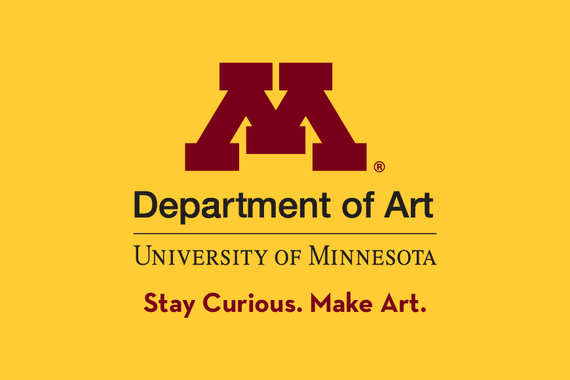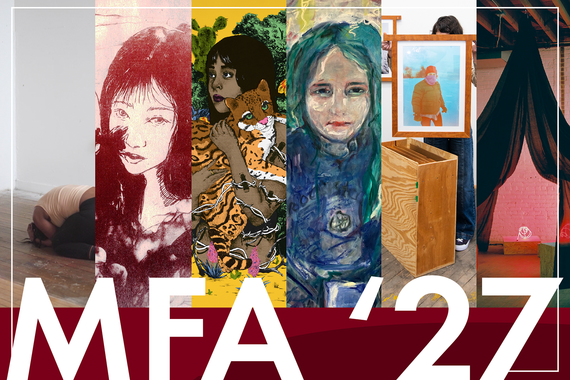Art Alum Amira McLendon Curates Murals from the Minneapolis Uprising
This week marks the opening of Art and Artifact: Murals from the Minneapolis Uprising at the Katherine E. Nash Gallery, an exhibition of murals that were painted on plywood in the aftermath of the murder of George Floyd by the Minneapolis Police. During the uprising, business owners across the Twin Cities began to cover their storefronts with sheets of plywood which were soon turned into powerful messages and murals by artists, protestors, and community. The Cities were in turmoil and the urban landscape was transformed into a living visual chronicle of the moment.
During this time, Leesa Kelly founded Memorialize the Movement and began collecting and preserving these murals as businesses took them down. Memorialize the Movement has collected over 1,000 panels of plywood over the last four years and continues to do so today, along with exhibiting these murals for the purpose of keeping George Floyd's memory and the story of the uprising alive and fresh in people's minds.
During her time as an undergraduate, Amira McLendon (BA '24) began interning with Memorialize the Movement, where she became interested in archiving and curating, and this exhibition marks her curatorial debut, presenting a selection of the murals from Memorialize the Movement's collection in the largest gallery exhibition of the murals to be presented to date.
Department of Art Communications Specialist Russ White sat down with Amira to learn more about how this exhibition came together and what Amira hopes visitors to the Nash Gallery will take away from the exhibition.
Russ White: Seeing all these murals really took me right back to that time of the uprising in the summer of 2020, and I imagine it will do the same for a lot of people who lived through it, as well. What was your experience of the uprising and how did you get involved working as an intern for Memorialize the Movement and then as a curator of this show?
Amira McLendon: 2020 was interesting for me because I had just graduated high school in 2019, so I was in my second semester of college and was still living at home in Apple Valley at the time. I grew up in a family that was very social justice-minded — my grandma founded this nonprofit called African American Academy for Accelerated Learning (AAAL). I was in that program since I was a baby, and that was my foundation for how I viewed the world as a Black kid growing up in the suburbs of Minnesota. In terms of being activated, this was really my first time that I had started asking how do I build community with other people and what can I do to play my part? During most of that summer I spent most of my time volunteering. There was one particular memory that stands out in which my mother, sister, and I helped hand out water and snacks to protesters. There were times between supply runs for food shelves where we would just drive around and seeing the city covered in murals was heartwarming. I saw a lot during that summer that stuck with me.
I started interning with Memorialize the Movement in January of 2022, so about a year and a half after everything happened. I felt like I had finally kind of found my place being able to blend art and activism and work on something fulfilling. It was super eye-opening for me because being a curator was the farthest thing from my mind in 2022. I came to the U as an art student with little direction in terms of what I wanted to be, maybe I would go into animation or video games. Working in curation and archiving was the farthest thing from my mind.
Since then, I’ve had a lot of conversations about representation in the art field and what that looks like. Without MTM, I don’t think I would’ve considered doing anything like I am now. Working for a young organization like MTM allowed me to explore and learn more about areas like curation that I probably wouldn’t have been able to elsewhere. In 2022 I was the co-curator for Justice For George: Our Strength, Our Story, less than 6 months into my internship, which was how the seed was planted. Now, in 2024, I’m curating this exhibition.
RW: Do you plan on continuing this work with MTM?
AM: Leesa Kelly, the founder and Executive Director of Memorialize the Movement, has hired me to be the Collections Manager, so I'm going to keep working with MTM. I want to go to graduate school in 2027 and continue doing work not just in collections or archiving but also further developing a philosophy of curation and delving deeper into cultural studies. MTM got me into this field, so I want to help continue to build up the organization and hopefully inspire the people that come after me.
RW: In terms of curation, this is just a small collection of the many murals in MTM’s collection. How big is the MTM collection, and what was your process for choosing this selection of works for the exhibition?
AM: It’s so big. There's so much; I feel like I’ve only just really gotten to see the whole collection. There are hundreds of panels and then multiple panels can make up a single mural. When it came to picking what was going to be in this exhibition, the easiest thing for us to do was figuring out the theme and then working our way from there. My thought for this exhibition was to look back at 2020 and reflect, then think about where we are now, where we're going, and what our roles are to get there. Those are the questions that I want to pose to people as they come into the exhibition.
RW: In the same way that I imagine that this exhibition will have a very direct impact on the people who were here in Minneapolis in 2020, what do you hope that this exhibition will communicate to people who didn't live through the uprising?
AM: I wrote an essay for the catalogue as a call to action for people, and I specifically wrote a section addressing people from Minneapolis and the state of Minnesota and then addressing people outside of Minneapolis and Minnesota, and my hope is that when people come and they're not from here it gets them to reflect on the injustices that have happened where they're from.
Because one of the things that I talk about a lot is that this isn't an isolated incident in the US. This is something that's happened in every state at this point in terms of Black people facing police brutality. So as much as this instance with George Floyd is Minnesota-focused, this isn't just a Minnesota issue in my opinion; this is a nationwide issue — a world issue — that we're continuing to deal with day in and day out. George Floyd's face and name isn't the only name in the gallery because this happens so frequently. I hope that people from outside of Minnesota can pick up on that and think about what's happened in their own communities and use what happened here as a catalyst for change in their communities as well. Every name deserves to be remembered.
RW: Do you think that these works change going from being outside, boarding up windows or as public murals, to then moving inside into a fine art gallery?
AM: Yeah, I think they do in the sense that just seeing these on the street feels a lot different than when they're all together in the same room. I won't necessarily say that it's a stronger or weaker impact, but the impact is different. One thing we think about often in MTM is that had these not been collected in the first place, these pieces may have been lost entirely. At the end of the day, bringing them into the gallery here allows them to continue to be seen and experienced by the community as pieces of our history.
RW: And it’s in the title as well, right? Art and Artifact, presenting these as historical documents in a sense, sharing them in an academic setting as pieces of history.
AM: Yeah, that's something we talk about with MTM a lot, with Leesa being Executive Director and then me being the curator of this exhibition: we're both Black Americans, and George Floyd and many of the other faces and names in the exhibition were Black Americans, too. This idea of Black people being able to tell their own stories and steward their own history is so important as we live in a country that has historically and in many ways still continues to stifle our voices. I think institutions have a role to play in uplifting our voices and the voices of others that haven’t always been heard.
RW: And in terms of the murals themselves, there's a degree of elevation of the “art object” that can happen when you put it in a white cube gallery, but that's not really what's happening here. There's sort of an equalizing that’s happening between street art that isn’t gatekept and this institutional space, meeting in the middle at this sort of 60-inch center. There's an interesting tension there.
AM: And I think right off the bat, that's why we chose some murals that also aren't very “artistic,” for lack of a better term. There are some murals in this show that are just spray painted writing on a sheet of plywood, without a fancy background or beautiful script or anything — it's just a straightforward message. It was important for us to pick murals that weren't just pretty to be here in this traditional gallery space because the visual appeal of these murals isn’t the only thing about them that’s important. These were the messages that the protesters, artists, and community members wanted to leave to express their anger, grief, and hope. I’m glad that everyone can come and experience these in a space where they can take their time and sit with them as well.

Art and Artifact: Murals from the Minneapolis Uprising is on view September 10 – December 7 in the Katherine E. Nash Gallery, with a Public Program & Opening Reception on Saturday, September 14, 6 – 9pm.
Gallery hours: Tuesday - Saturday, 11 am – 5 pm
Regis Center for Art (East)
405 21st Avenue South
Minneapolis, MN 55455



